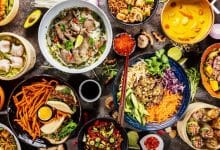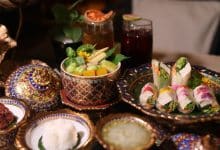Everything you need to know about Thai food
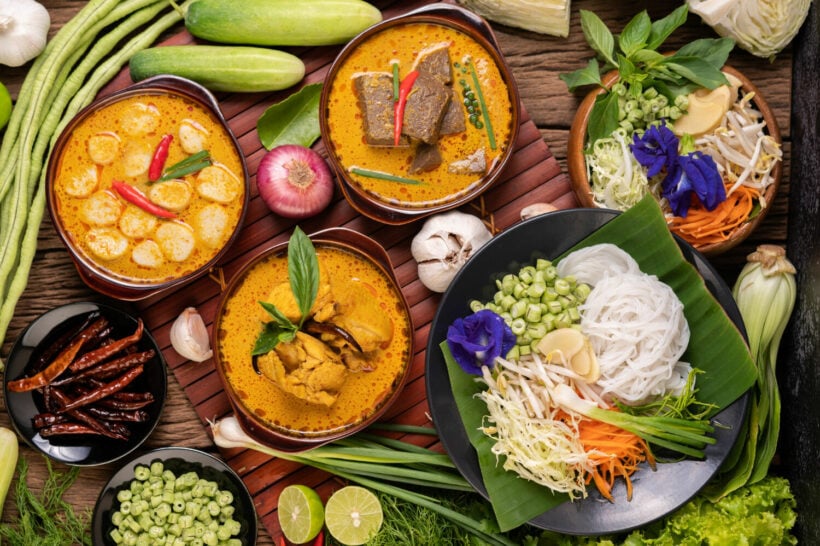
If you’re travelling to Thailand or you live in Thailand, exploring Thai cuisine is something you shouldn’t miss. Thai food has a unique and interesting taste, making it one of the most popular cuisines around the globe. But what makes Thai cuisine so interesting and so well loved? What are the essential ingredients in Thai cuisine to create such a unique taste? Well, to answer your questions, here is everything you need to know about Thai food.
The Influences in Thai Cuisine
The traditional Thai cuisine that we know and love today is heavily influenced by Chinese cuisine. Numerous cooking techniques, such as frying, stir-frying, and deep-frying in Thai dishes, are all obtained from Chinese cuisine. In addition, the Chinese are said to have brought noodles (or kuay tiew) and steel wok to Thailand many centuries ago.
Indian spices and flavours also have some influence on Thai cuisine. The sheer number of curries in Thai cuisine, including green, red, and yellow curries, is evidence of this influence. While Thai curries consist of many Indian spices in their pastes, they have their own unique flavours that won’t be mistaken for Indian curries. This is because Thai curries incorporate local ingredients such as Thai holy basil, galangal, and lemongrass.
Over centuries, Thailand and its neighbouring countries mutually influenced one another’s cuisine. The cooking in the South of Thailand has some culinary influences from Indonesia and Malaysia. On the other hand, the cuisine in the north and northeast of Thailand is influenced by Laos, Vietnam, Cambodia, and Myanmar.
Other influences on Thai cooking come from Japan, Dutch, French, and Portuguese. With such vast influences, it’s no wonder that present-day Thai cuisine has a complex and delicious taste.
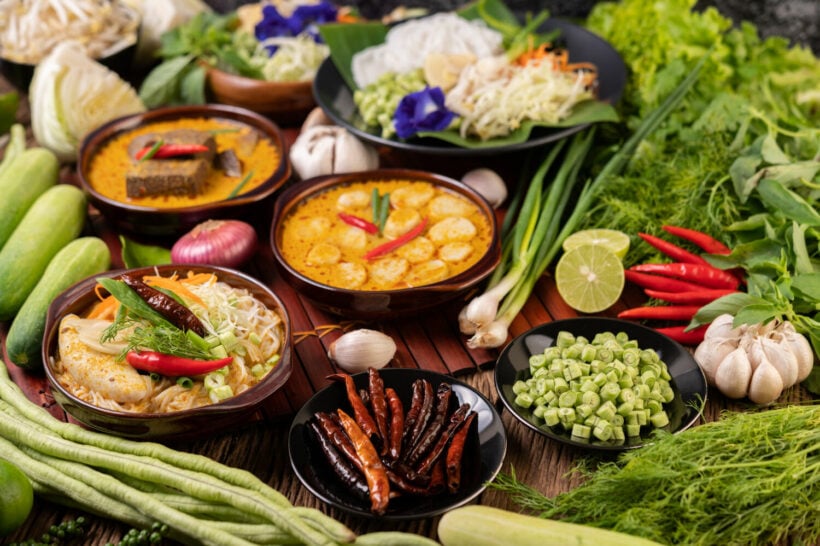
The Key Flavours of Thai Cuisine
What makes Thai food so interesting is that most dishes have a fantastic balance of sour, sweet, salty, bitter, and spicy – or at least two, if not all, of these flavours. One flavour will be dominant, but there will also be layers of the other flavours to enrich the overall taste. In addition, the flavours are often finished with aromatic herbs.
Knowing your ingredients and the right amount of each is essential to find balance in each dish.
Sour
The citrusy sour flavour that you can taste in many Thai cuisines mainly comes from lime juice and lemongrass. In addition, the rich sweet-sour aroma usually comes from lime leaves. To sharpen the sour taste, many Thai foods also consist of tamarind.
Salty
The salty taste in Thai dishes typically comes more from soy sauce and fish sauce instead of salt. The soy sauce provides a light earthy flavour, which blends perfectly with vegetables and protein ingredients. The fish sauce brings a rich umami taste that completes the flavour of almost every Thai food.
Sweet
The main sweet flavours in Thai cuisine mainly come from palm sugar, coconut sugar, brown sugar, and dark soy sauce. Sweetness isn’t limited to desserts as it’s the core flavour of many other Thai dishes as well.
Spicy
The spiciness in Thai food comes from chilli, galangal, ginger, and peppercorns. These ingredients are usually present in soups, curries, as well as meat and seafood stir-fries.
Bitter
The bitterness of some Thai food comes from raw leaves from various plants or bitter melons.
Besides the five primary flavours, some Thai dishes are also creamy, which tempers and evens out the spiciness of the cuisine. Coconut milk is the main ingredient to create this creaminess. You can find numerous Thai dishes, including curries and soups, that consist of coconut milk.

Types of Thai Cuisine
Thai food is very diverse. However, it can be classified as noodles, curries, salads, chilli pastes (nam prik), desserts, and snacks.
Noodles
One of the most popular street foods in Thailand is noodle dishes. There are numerous forms and variations of noodle dishes in the country, such as Pad Thai, Khao Soi, and Pad See Ew. You can typically customise noodle dishes to your own liking, such as the types of noodle, with or without soup, and the kind of soup.
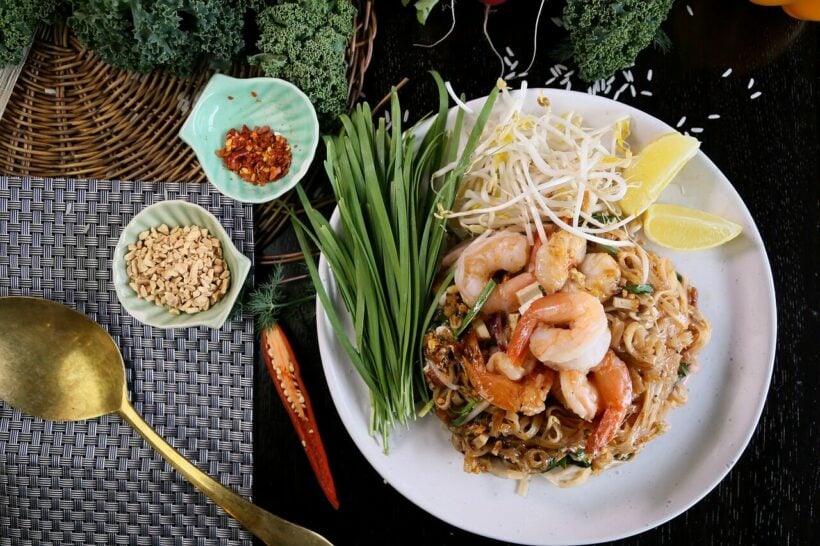
Curries
There’s a wide range of Thai curries. However, the 5 main types are as follows:
Red curry
Also known as spicy curry, red curry is heavily spiced with red chillies, which gives it its bright colour and fiery taste. The chillies are often crushed together with garlic, shallots, lemongrass, and blue ginger. Then, the curry paste is mixed with coconut milk to produce a creamy curry sauce.
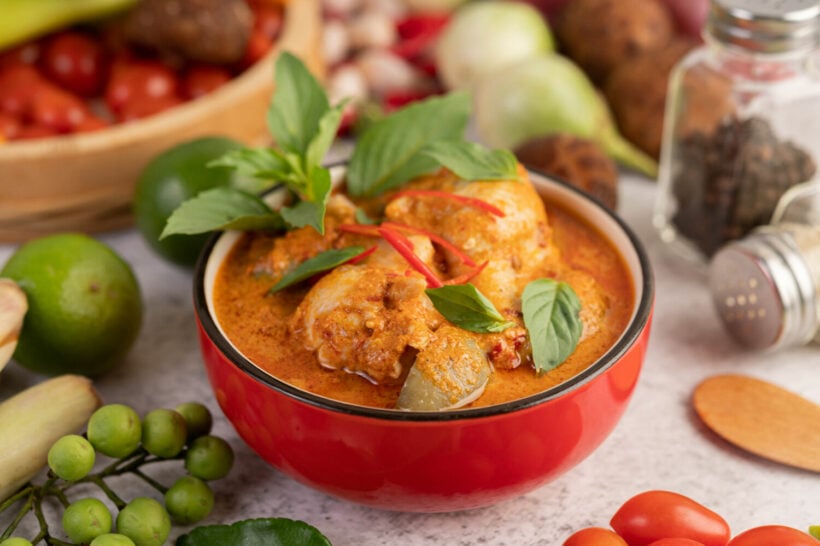
Green curry
Green curry is often considered the hottest and most popular Thai curry. This sweet and spicy curry derives its colour and heat from an excessive amount of fresh green chillies. It also consists of copious amounts of lime juice and coconut milk. In addition, it uses kaffir lime leaves, garlic, shallots, turmeric, blue ginger, Thai basil, kra chai, galangal, and coriander root, which give it an aromatic fragrance and interesting taste.
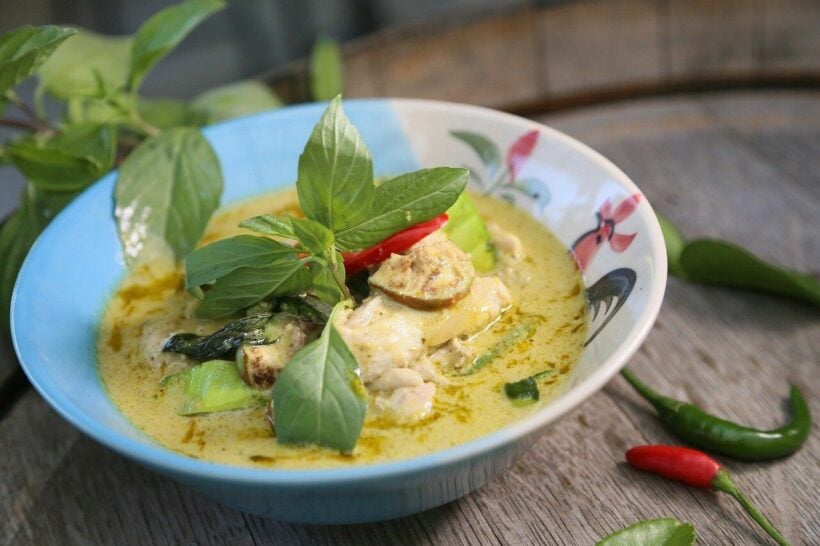
Yellow curry
Compared to the green curry and red curry, the yellow curry is milder and not very spicy. The yellow colour comes from a lot of turmeric in the ingredients. The paste is mainly made of dried spices, such as coriander, cumin, turmeric, fenugreek, lemongrass, cinnamon, cayenne pepper, garlic, and bay leaves. The taste is very rich and savoury.
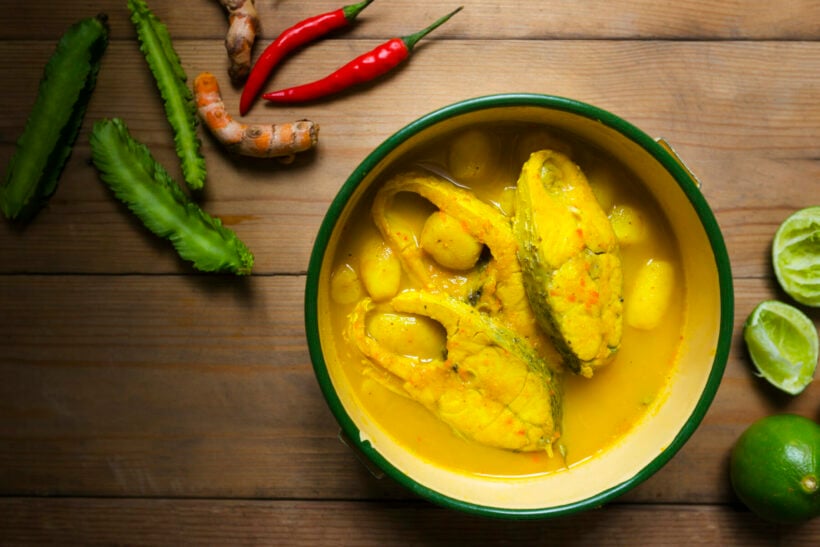
Massaman Curry
Massaman curry is an Islam-influenced curry that offers an exotic taste. It’s mild, sweet, and consists of spices that are usually found in Indian cuisines, such as cinnamon and cardamom. Aside from these two ingredients, the paste is made using garlic, red chillies, blue ginger, lemongrass, shallots, cloves, cumin, nutmeg, and coriander. The sauce also includes kaffir lime leaves and coconut milk. Potatoes and peanuts are also added to top it off. Massaman curry is particularly popular in central and southern Thailand.
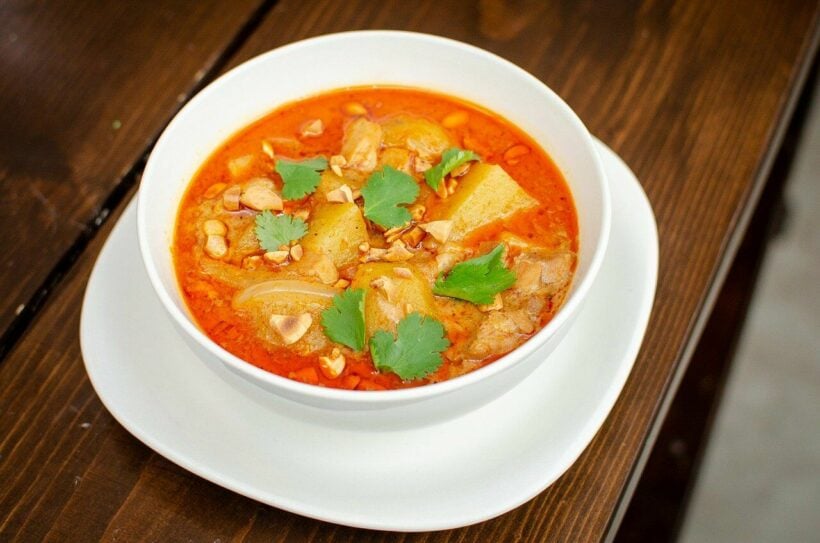
Panang Curry
Panang curry has its roots in Laos. It’s thick but more subtly flavoured and milder than other types of Thai curries. It’s slightly sweet and slightly salty, with peanuts dominating the flavour. Panang curry consists of dried chillies, lemongrass, coconut milk, garlic, shallots, kaffir lime leaves, blue ginger, cumin, cilantro, shrimp paste, and many more ingredients.
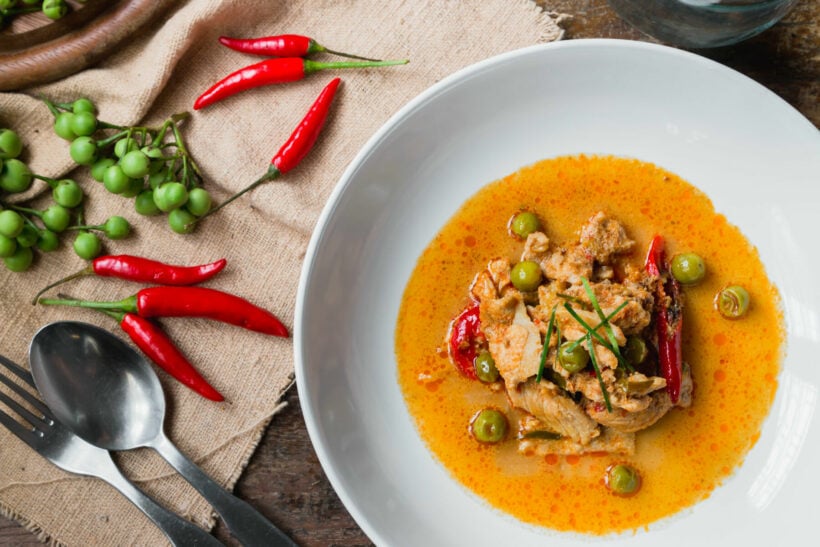
Thai Salads
In Thailand, salad is commonly known as Yum, which means “mix.” There are a wide variety of salads around the country, but the main ingredients usually include seafood, meats, fresh fruits, and noodles. The main ingredients are then mixed with sliced tomatoes, peanuts, lime juice, fresh chilis, sugar, fish sauce, onions, and herbs. The taste of Thai salads is mostly sour and spicy.
Salads can be eaten as the main dish or side dish (shared with others). Yum Mama (instant noodle salad) and Yum Woon Sen (spicy glass noodle salad), are two of the most popular salads among Thai people. Som Tum (papaya salad) is also very popular.
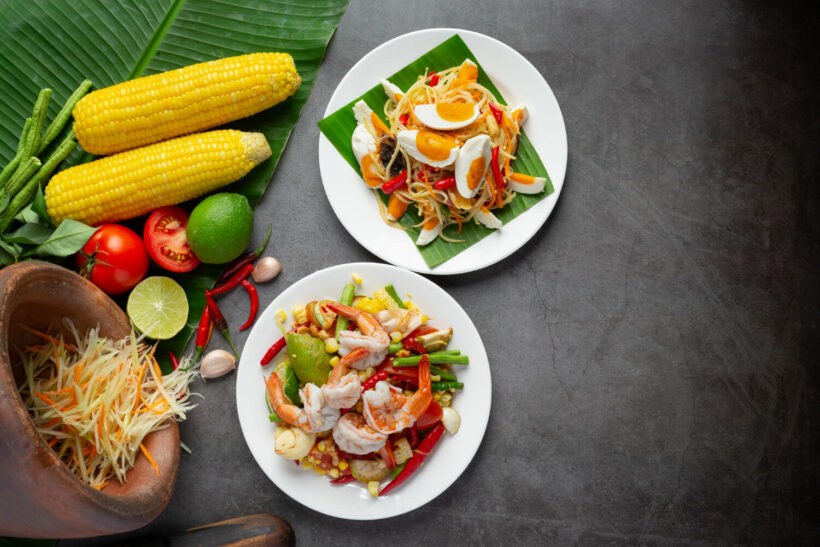
Thai Chilli Pastes (Nam Prik)
Nam Prik or Thai chilli paste is a general term for any spicy chilli paste that is served with many Thai dishes, particularly with rice or sticky rice. It’s eaten as a dipping sauce with meats, fish, and vegetables. There are approximately 200 types of nam prik in Thailand, and different regions have different recipes.
The most popular type of nam prik is Nam Prik Kapi (chilli paste with fermented shrimp), Nam Prik Pla Too (chilli paste with deboned mackerel fish), Nam Prik Ong (chilli paste with tomato and pork), and Nam Prik Pla Ra (chilli paste with fermented fish). The essential ingredients of nam prik are herbs and spices. Besides being eaten as a dipping sauce, nam prik is also commonly used as a base ingredient to cook numerous Thai foods.
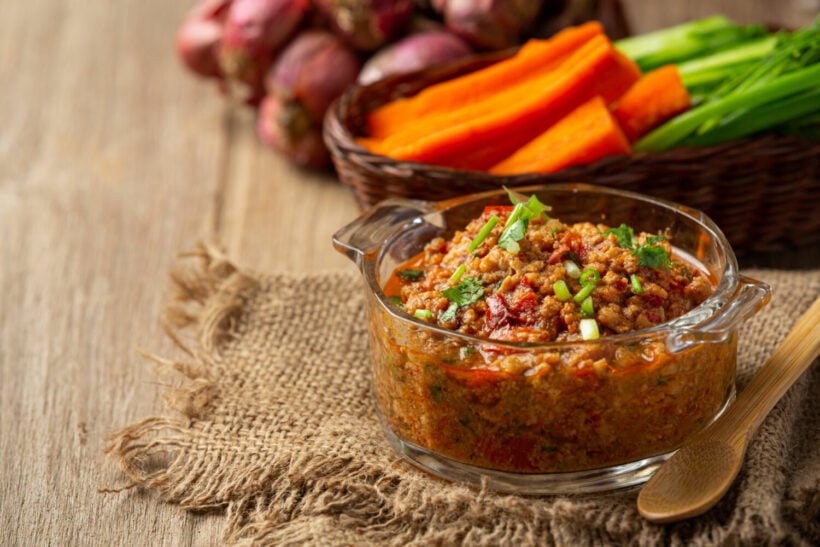
Thai Desserts
There are countless types of desserts in Thailand. In the old days, traditional Thai desserts only used sugar, coconut, and flour as the main ingredients. Later, desserts made from eggs were introduced during the Ayutthaya period by Portuguese missionaries. As a result, Thai desserts now come in a wide variety, with numerous different shapes and beautiful colours.
To make it simpler, Thai desserts are often classified as:
Rice desserts: Kao Niew Ma Muang (mango sticky rice), Khao Tom Mud (banana sticky rice).
Pancakes: Roti (Thai pancakes), Khanom Buang (sweet Thai crepe).
Fruit-based desserts: Gratorn Song Kreung (candied santol fruit), Gluay Buad Chee (sliced bananas in coconut milk).
Jelly or custard desserts: Khanom Chan (Thai jello), Khanom Krok (mini coconut pancake).
Soup and toppings:Tub Tim Krob (red ‘rubies in coconut milk), Bua Loy (tapioca balls in coconut milk).
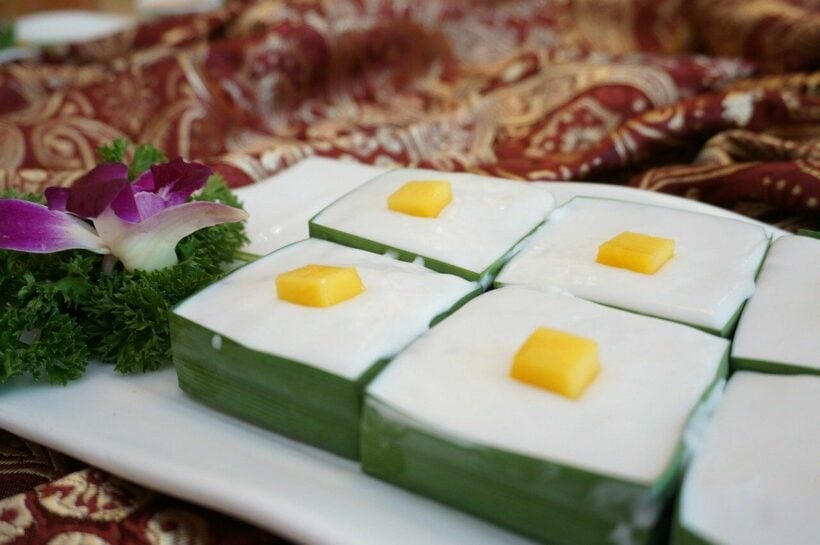
Thai Snacks
Besides meals and desserts, Thai people love to eat snacks! You can easily find quick and delicious snacks at marketplaces or along the roadside in Thailand. Some of the most popular snacks are spring rolls, Pa Tong Go (Thai-Chinese fried pastry), chicken or beef satay, and Salapao (Chinese steamed bun).
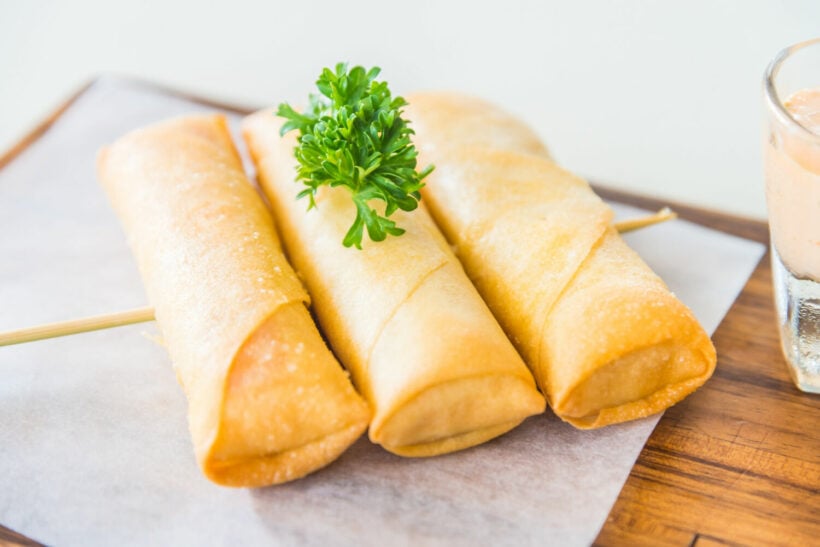
Regional Variations
Thailand is traditionally divided into 4 regions: Central, South, North, and Isaan (Northeast). Due to the ingredients found in each region, local customs, culture, climate, and influence from neighbouring countries, Thai food is region-specific.
Central Thai Food
Central Thai food is the most unique. In most traditional dishes of this region, you can taste a good balance of flavours – salty, sour, sweet, and spicy. The region is also known to use the most curries and coconut milk. In addition, due to its central location, the region often utilised specialities from both the south and north of Thailand in their cuisine. Some of the most popular Central Thai food include Hor Mok Pla (Thai curried fish custard), Pad Kra Pao (Thai basil stir-fry), Tom Kha Gai (Thai coconut chicken soup), Thong Yod (gold egg yolk drops). You can find these dishes in many places across Central Thailand, including Bangkok.
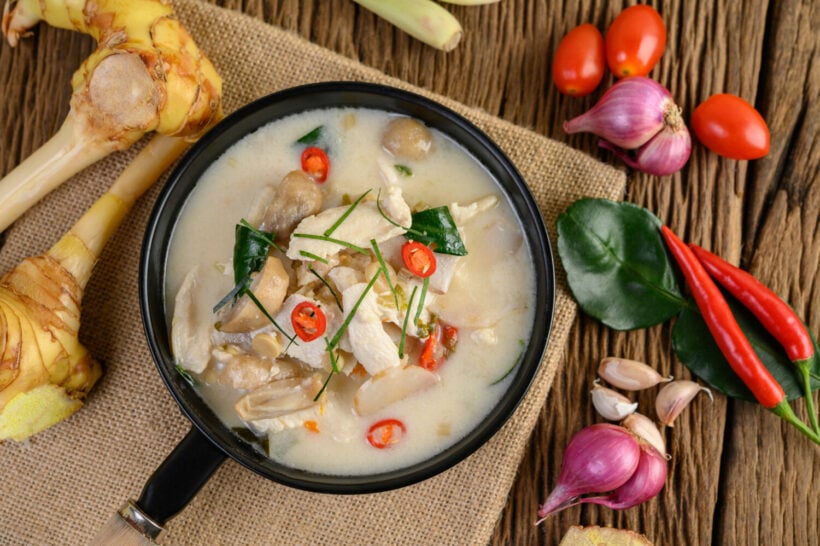
Southern Thai Food
Southern Thai food offers a delightful mixture of authentic Thai cuisine and Indian cuisine. Since the majority of food from the region contains lots of spices, the flavour of southern Thai food can be very intense – you’ll find both the saltiest and the spiciest dishes here. One of the most popular dishes in the South is curries. The curries here tend to be very thick and spicy when compared to the curries in the north. In addition, thanks to its proximity to the sea, seafood and coconut are in abundance in the south of Thailand. That’s why many of the region’s signature dishes contain both seafood and coconut milk in the ingredients. Must-try dishes from southern Thailand include Gaeng Som Pla or Gaeng Leung (spicy and sour fish curry), Sataw Pad Kapi Goong (stink beans with shrimp), Kua Kling (Thai dry curry), and Tom Som Pla Krabok (sweet and sour fish soup).
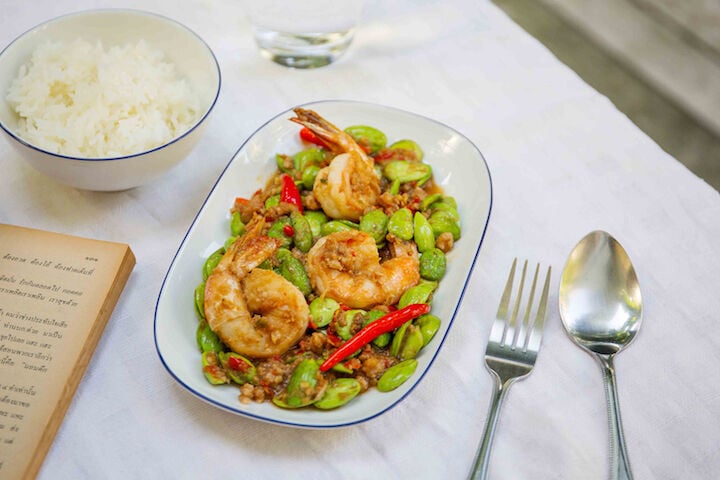
Northern Thai Food
Northern Thai food is typically milder in taste when compared to southern Thai food. Most Thai dishes from the north are a bit salty but rarely sweet or sour. The subtle sweetness in most dishes comes from ingredients like fish and vegetables instead of sugar. Since the northern region has the perfect climate to grow vegetables and herbs, the dishes consist of plenty of herbs and vegetables. Also, northern Thailand borders Myanmar and Laos, so these particular countries influence most of its food. The staple of the Thai meal in the north is Khao Niaow (sticky rice), instead of white rice like most other parts of Thailand. Khao soi (coconut curry noodle soup), Khanom Jeen Nam Ngiao (spicy noodle soup), and Nam Prik Noom (green chili dip) are some of the most popular dishes from the north of Thailand.
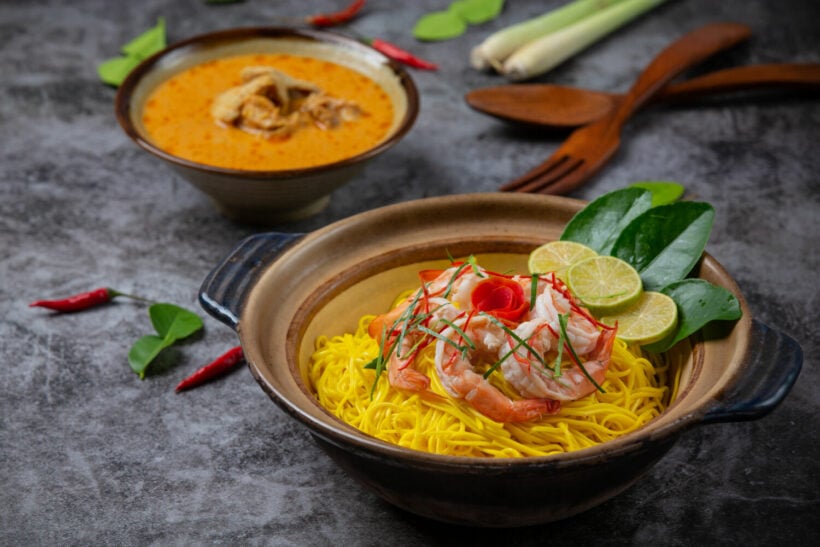
Isaan Food
Isaan food, or Northeastern Thai food, is generally a little healthier than popular dishes in central Thailand since most of the food is grilled or boiled instead of fried. The main characteristics of Isaan food are spicy and dry. A lot of the food also includes Pla Ra (fermented fish). While the foods are usually salty and spicy, they’re usually not too strong. The most popular Isaan foods you need to try are Kai Yang (grilled chicken), Larb Moo (minced pork salad), Som Tum (papaya salad), and Tom Saep (spicy and sour soup).
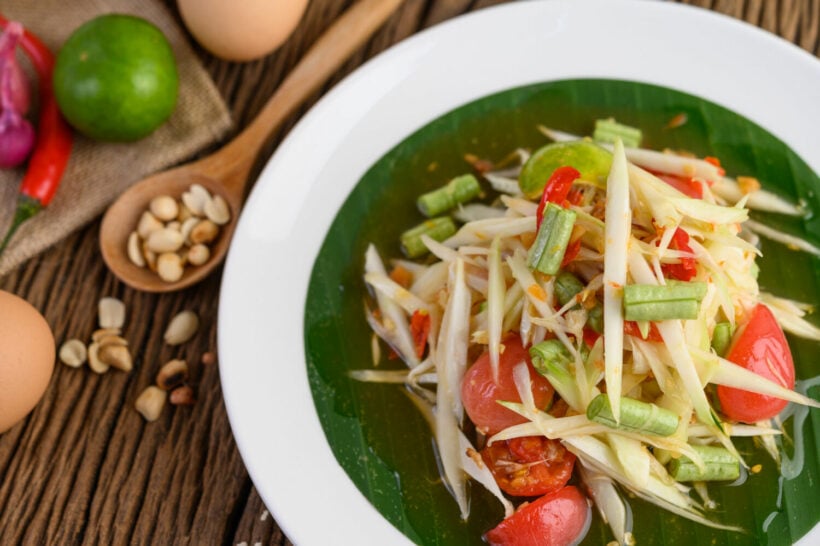
Royal Thai Food (Aharn Chao Wang)
If you’ve been to a Thai restaurant, you might have come across the term “Royal Thai Cuisine” or “Royal Thai Food” on the menu, but what is it?
In Thai, “Chao” means “the people of” and “Wang” means “palace.” Aharn Chao Wang means the “food of the people in the palace.” It’s been around for centuries since the Ayutthaya Era. At the basics, it’s similar to most other central Thai foods. However, it has specific rules and higher standards. For example, the dishes shouldn’t have bones, stones, or pits. Also, the ingredients used have to be the freshest available. The flavours must also be perfectly balanced, without any intense flavour in any particular direction – not too spicy, salty, sour, sweet, or bitter. Besides its expensive ingredients and mild taste, Royal Thai Cuisine also comes in lavish presentations.
In the past, only the wealthy could afford to eat them. However, Royal Thai food is now more widespread since the ingredients are more affordable and readily available. While Thais still consider it luxurious, you can now find it in numerous restaurants across the country.
Some of the most popular Royal Thai Cuisine that’s still popular today include Por Pua Thod (deep-fried spring roll), Panang Neua (beef dried curry), and Yam Tua Pu (wing bean salad).
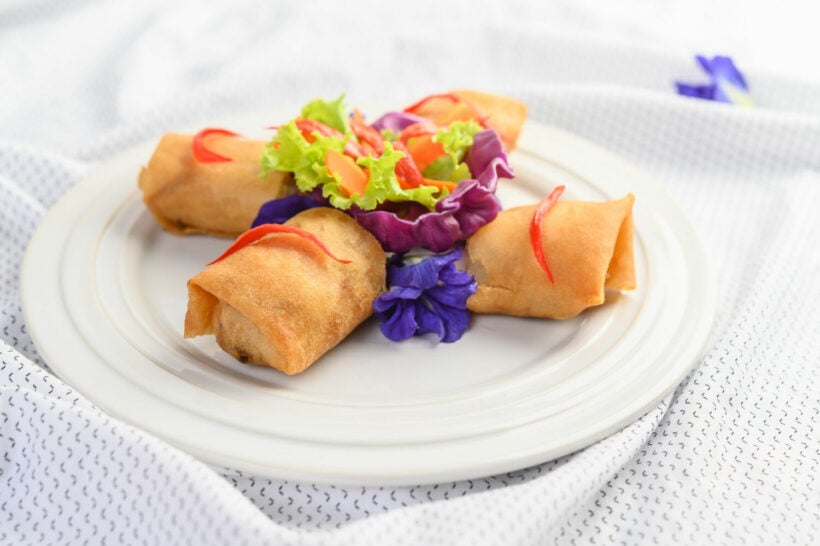
Thai Eating Habits
It can be hard to tell what’s the difference between breakfast, lunch, and dinner in Thai food as most dishes are interchangeable. This can eat pretty much the same foods for breakfast as for lunch or dinner because it’s normal to eat foods served with rice every meal. Here are some eating habits in Thailand.
Thai Breakfast
Between 7 am to 8 am is breakfast time in Thailand. While breakfast, lunch, and dinner are often interchangeable, some foods can be considered typical Thai breakfast. These foods are usually easy to make and eat, meaning you can grab and eat them during rush hour or along the way to work. Below are some of the most popular Thai breakfasts:
Khao Kai Jeow (Omelette and Rice): This is a simple and cheap breakfast. You can easily make it at home or pick it up on the street. It’s a traditional Thai fried omelette, which has a puffed-up texture created by frying whisked eggs in hot oil. Most people combine the egg with green onions and fish sauce. It may also consist of ground beef or pork. It normally costs around 40 to 50 Baht.
Khao Tom (Thai Rice Soup): Khao Tom can be found in many places across Thailand, from street food to hotels’ breakfast. It’s basically boiled rice served with your meat of choice, herbs, vegetables, and sometimes an egg. You can find it for as little as 15 baht per bowl at roadside shops.
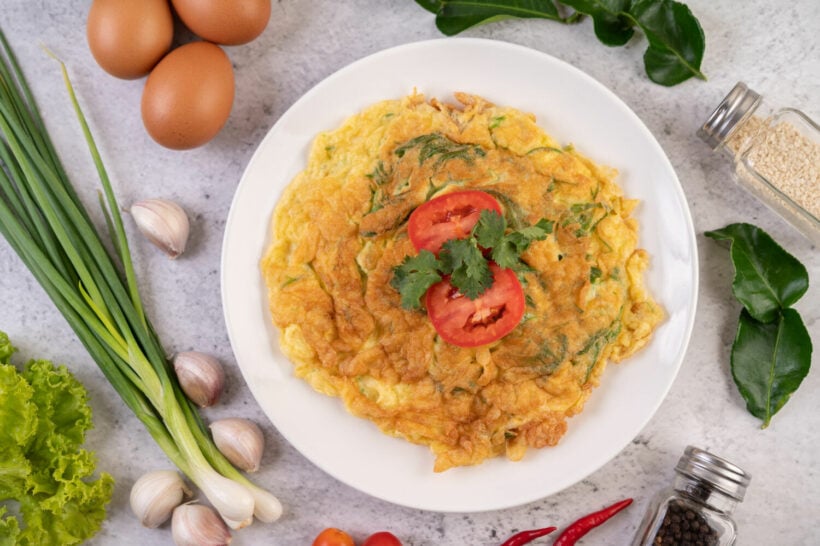
Thai Lunch
The typical lunchtime in Thailand is between 12pm to 1pm. Most Thais like to go out for lunch, and the choice is enormous. Some Thai lunch dishes only takes around 3 fo 5 minutes to make, such as:
Pad Thai Goong (Thai stir-fried noodles with prawns): Pad Thai Goong is a version of the popular Pad Thai that includes prawns. You can find it in many areas in Thailand, especially the south. This stir-fry noodle dish has a sweet and sour taste that won’t only delight your taste buds but also fill you up quickly. It costs around 30 to 40 baht per portion.
Khao Pad (Thai-Style Fried Rice): Khao Pad has numerous different versions. However, it usually consists of the same basic ingredients, such as rice, egg, cilantro, onion, garlic, soy sauce, and meat of your choice.
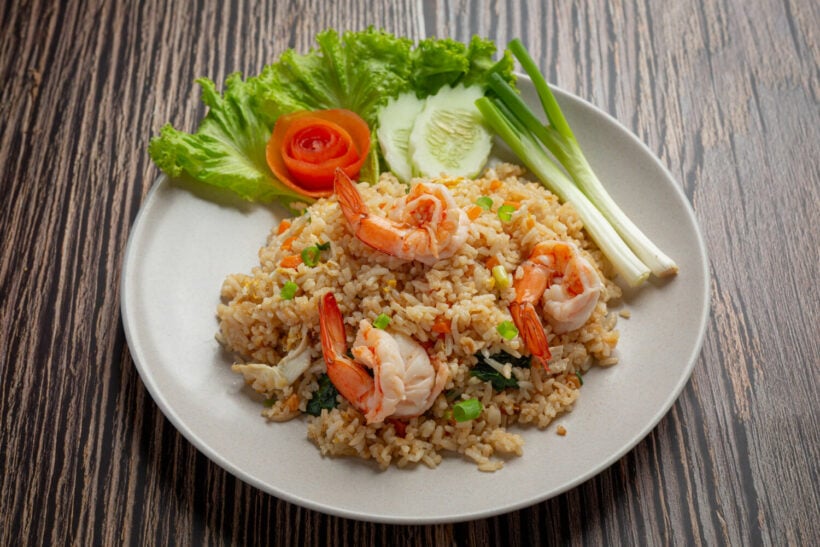
Thai Dinner
Dinner in Thailand is usually the biggest meal. It’s more elaborate than breakfast and lunch, with dishes that take longer to prepare. Thais usually eat dinner between 6 pm to 8 pm. In the evening, you usually get more choices of delicious food.
Besides restaurants, you can find numerous food stalls on the street or at night markets. Most Thais consider dinner as a family meal, so many families will gather and have dinner together. Families or groups of friends who eat together usually have more than one dish on the table for everyone to share.
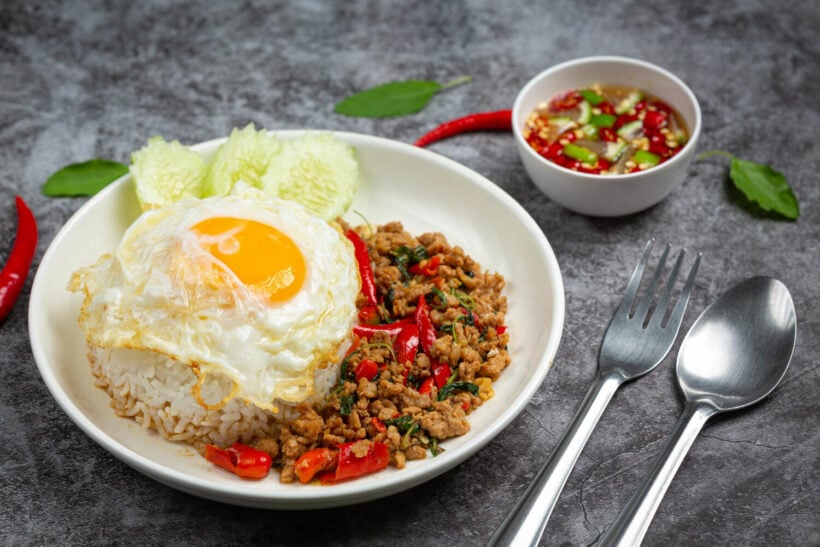
Since food is affordable and available everywhere, many people in Thailand prefer to buy food instead of cooking it themselves. Quickly grabbing food from the streets, markets, or restaurants is often easier and cheaper.
Cutlery and Eating Style
It’s true that the Chinese brought chopsticks to Thailand a long time ago and that you’ll find chopsticks in some Thai homes. However, most Thais prefer to use Western cutlery their own way. Thai people usually don’t use the knife when eating because most ingredients in Thai dishes come already cut up. Instead, they opt to use a fork and a large spoon.
Although Thai foods often consist of ingredients placed on top of rice, Thais usually don’t combine various foods on their plates when eating. They usually keep them separate, sampling one dish at a time. So, for example, if you have a plate with rice, vegetables, and chicken, eat each part separately.
And now with the recent Western trend or even obsession with the air fryer, some ‘hi-so’ Thai’s are jumping on this trend and cooking meals in rapid times. But to the traditionalists, these devices are seen as sacrilege and only time will tell if these speed cooking devices will match well with Thai cooking traditions!
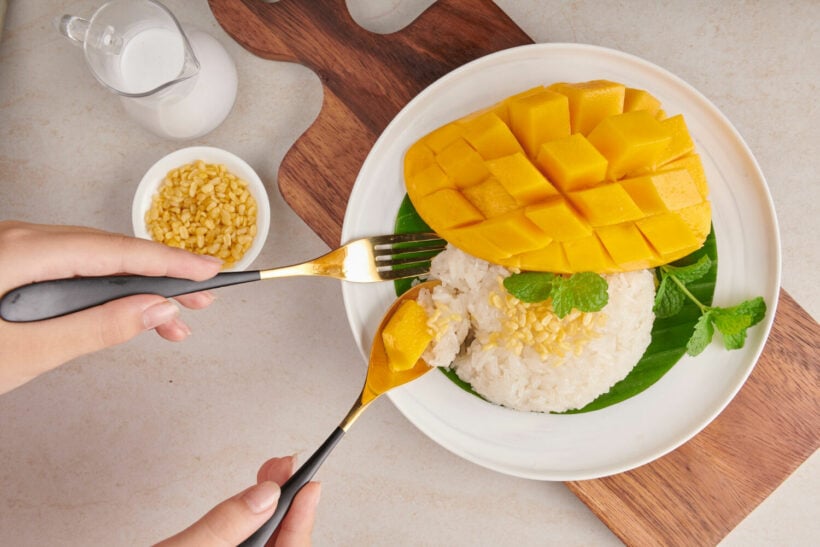
Now that you know all the basics of Thai cuisine, you’re ready to embark on a Thai food journey and maybe even start to eat like a local!
Can’t decide which Thai food to try? Check out our article on the top 10 Thai food you absolutely need to try.
Latest Thailand News
Follow The Thaiger on Google News:
